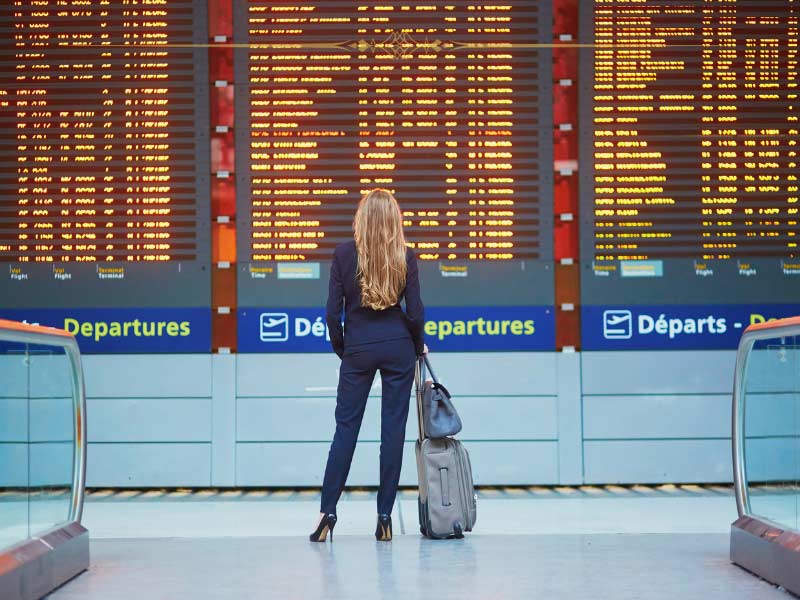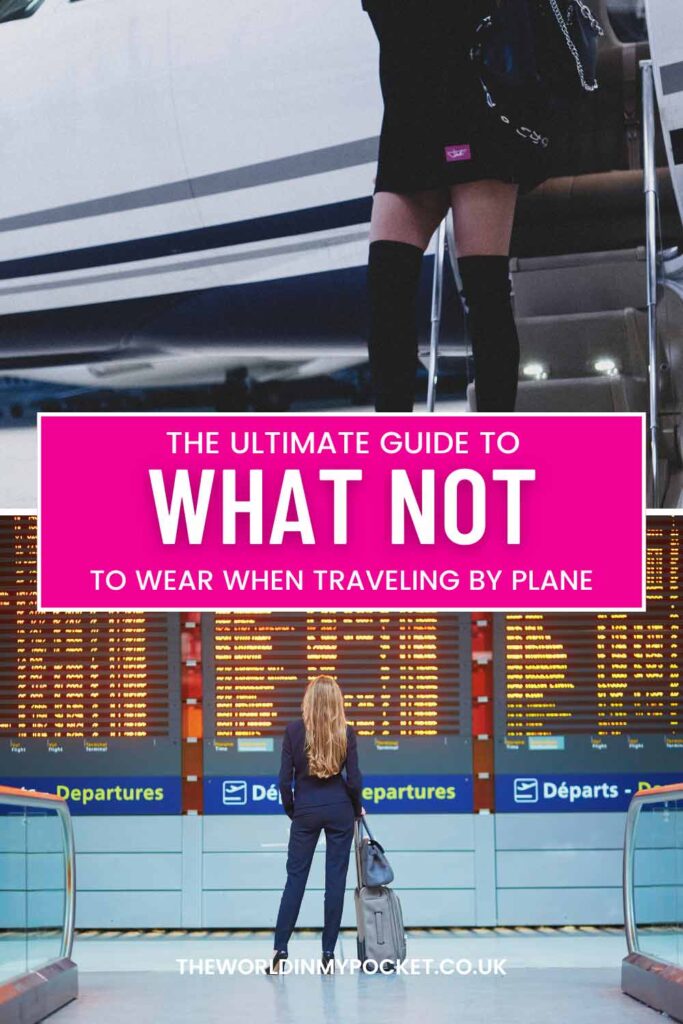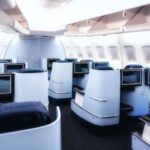Amid the excitement of planning destinations and activities, many travelers overlook a crucial aspect of their journey: what they wear on the plane. Your in-flight attire can significantly impact your comfort, safety, and overall travel experience. From circulation concerns to emergency protocols, your clothing choices matter more than you might think.

This comprehensive guide explores the garments and accessories best avoided when flying, helping you make informed decisions for your next journey through the skies.
The Hidden Dangers of High Heels
When preparing for air travel, many passengers prioritize style over practicality, particularly when it comes to footwear. High heels, especially stilettos, may complement your travel outfit aesthetically, but they present several substantial risks during flights.
Airport terminals often require extensive walking. From navigating check-in areas to rushing between gates for connecting flights, the average traveler walks significant distances. High heels increase fatigue and the risk of ankle injuries during these lengthy treks.
More critically, aircraft emergency protocols directly conflict with elevated footwear. During evacuation procedures, passengers may need to use inflatable slides—devices that can be damaged by sharp heels. Flight attendants typically instruct passengers wearing such footwear to remove them before evacuating, wasting precious seconds in time-sensitive situations.
Additionally, the confined space of airplane cabins makes navigating narrow aisles in heels challenging and potentially hazardous, especially during turbulence when maintaining balance becomes essential. The combination of unsteady footing and unexpected aircraft movement creates unnecessary risk.
For safer, more comfortable travel, opt instead for flat, closed-toe shoes that provide stability and protection. Comfortable sneakers, loafers, or other supportive footwear will serve you better throughout your journey.
Open-Toed Footwear: A Gateway for Germs
While sandals and flip-flops might seem like convenient choices for swift passage through security checkpoints, they expose travelers to numerous health hazards throughout their journey.
Airport floors harbor an astonishing variety of microorganisms. From restrooms to security screening areas where passengers walk barefoot, these surfaces accumulate bacteria and fungi from thousands of daily travelers. Open footwear leaves your feet vulnerable to these pathogens, increasing your risk of contracting conditions like athlete’s foot or plantar warts.
Aircraft cabins present additional hazards for exposed feet. The circulation of cabin air means that dust, debris, and germs are constantly moving throughout the space. Spilled beverages and food crumbs frequently find their way to the floor, creating not only unpleasant conditions but potential health risks for those with exposed feet.
Beyond hygiene concerns, open footwear provides minimal protection in emergency situations. Aircraft evacuations may require navigating through areas with sharp debris, hot surfaces, or other hazards that could severely injure unprotected feet.
Prioritize fully enclosed shoes for air travel to maintain hygiene and safety throughout your journey. This simple choice provides a protective barrier between your feet and the numerous hazards present in airports and aircraft.
The Circulation Risks of Overly Tight Clothing
Skinny jeans and compression garments have become fashion staples, but these constrictive items can pose significant health risks during air travel, particularly on long-haul flights.
Extended periods of immobility combined with the pressurized cabin environment already predispose passengers to circulatory concerns. The addition of restrictive clothing compounds these risks by further impeding normal blood flow, particularly in the legs. This combination creates ideal conditions for deep vein thrombosis (DVT), a potentially serious condition where blood clots form in the deep veins, typically in the legs.
Medical professionals consistently advise against wearing highly constrictive garments during flights. The risk factors intensify with flight duration, dehydration, and individual predispositions to circulatory issues.
The problem extends beyond skinny jeans to include various tight-fitting clothing items like compression shapewear and restrictive undergarments. These garments apply constant pressure to different body areas, potentially restricting circulation precisely when your body needs optimal blood flow.
Instead, select loose-fitting, breathable clothing that allows for natural movement and doesn’t constrict blood vessels. Wide-leg pants, relaxed jeans, or comfortable athleisure wear made from natural fibers provide both comfort and reduced health risks during air travel.
The Temperature Challenge: Avoiding Skin-Baring Tops
Aircraft cabins maintain temperature settings that often surprise first-time travelers. Despite departing from or arriving at warm destinations, cabin environments typically run cooler than expected, creating uncomfortable conditions for passengers dressed for warmer climates.
Sleeveless tops, crop tops, and other skin-revealing garments quickly become problematic in the regulated chill of airplane cabins. This issue extends beyond simple discomfort—exposure to cold temperatures in confined spaces for extended periods can contribute to lowered immunity and increased susceptibility to respiratory infections circulating in the cabin air.
Aircraft temperature regulation serves specific purposes beyond passenger comfort. Cooler settings help prevent overheating of onboard systems and reduce the risk of passenger lightheadedness at higher altitudes. These operational necessities mean cabin temperatures will consistently remain cooler than many passengers anticipate.
The solution lies in strategic layering. Begin with comfortable base layers and bring easily removable outer layers that can be adjusted according to changing cabin conditions. A lightweight cardigan, sweater, or packable jacket occupies minimal space in your carry-on but provides crucial warmth during flight.
This approach allows flexibility throughout your journey as you transition between the varying temperatures of departure terminals, aircraft cabins, and arrival destinations.
Fire Hazards: Synthetic Athletic Wear
Athletic clothing has revolutionized comfort in travel wear, with many passengers selecting leggings, yoga pants, and other athleisure items for their journeys. However, these garments often contain high percentages of synthetic materials that present unexpected risks during air travel.
Aviation safety experts highlight a concerning property of synthetic fabrics like nylon, polyester, and spandex: their behavior during fire incidents. Unlike natural fibers, these materials can melt when exposed to high temperatures, potentially adhering to skin and causing severe burns. While aircraft fires are rare, emergency preparedness remains a cornerstone of aviation safety.
Additionally, these synthetic materials typically provide less breathability than natural fibers, potentially contributing to passenger discomfort during longer flights. The reduced airflow can lead to increased perspiration and odor, particularly problematic in the close confines of aircraft cabins.
Travel safety specialists increasingly recommend clothing made from natural fibers like cotton, linen, or wool for air travel. These materials provide superior breathability and demonstrate safer behavior during high-temperature exposure, charring rather than melting onto skin.
While complete avoidance of synthetic materials may be impractical for many travelers, considering garments with higher percentages of natural fibers represents a reasonable compromise between comfort and safety.
The Bathroom Dilemma: One-Piece Garments
Rompers, jumpsuits, and other one-piece garments have gained popularity for their streamlined appearance and simplified styling. However, these fashion-forward choices become surprisingly problematic in the confined environment of aircraft lavatories.
Aircraft bathrooms rank among the most spatially restricted facilities that travelers encounter. The average airplane lavatory measures approximately 3 feet by 3 feet—dimensions that make even basic movements challenging. Navigating this limited space while wearing a garment that requires near-complete removal for bathroom use quickly becomes an exercise in contortion.
The impracticality extends beyond mere inconvenience. Aircraft lavatories present various hygiene concerns, from wet floors to limited touchpoints for balance. Garments that require extensive handling or risk touching bathroom surfaces create unnecessary exposure to germs and contaminants.
For passengers anticipating bathroom visits during their flight—particularly on longer journeys—separates provide the practical solution. Pants, skirts, or dresses with accessible closures eliminate the need for complex maneuvering in restricted spaces while maintaining style.
This simple adjustment to your travel wardrobe enhances convenience and hygiene throughout your journey without sacrificing aesthetic appeal.
Contact Lenses and Cabin Dryness
The environmental conditions inside aircraft cabins create specific challenges for passengers wearing contact lenses. While not technically clothing, these vision aids require special consideration during air travel.
Aircraft cabins maintain humidity levels significantly lower than what humans typically experience on the ground. While normal indoor humidity ranges between 30-60%, airplane cabins may drop to 10-20% humidity during flight. This extremely dry environment directly impacts the moisture content of contact lenses.
Passengers wearing contacts often experience increased eye irritation, redness, and discomfort as flights progress. The drying effect can cause lenses to adhere more strongly to the eye surface, potentially leading to micro-abrasions of the cornea and increased infection risk.
Extended exposure to recirculated cabin air compounds these issues, particularly on long-haul flights where passengers may wear contacts for 10+ hours continuously. The combination of dry air and extended wear creates ideal conditions for eye strain and discomfort.
Consider switching to glasses for your flight duration, particularly for journeys exceeding a few hours. This simple change significantly reduces eye discomfort and infection risks. If contact lenses remain necessary, bring preservative-free rewetting drops (in TSA-compliant sizes) and use them regularly throughout your flight.
Metal Accessories and Security Delays
Elaborate jewelry and metal-heavy accessories may complement your travel outfit, but they create functional complications at crucial points in your journey, particularly during security screening procedures.
Airport security systems are calibrated to detect metal objects, making extensive jewelry a guaranteed trigger for additional screening. Items like chunky necklaces, multiple bracelets, ornate belt buckles, and watches with substantial metal components all contribute to security delays.
The process of removing multiple pieces of jewelry while managing other belongings at security checkpoints creates stress and increases the risk of losing valuable items. Even after clearing security, metal accessories can trigger unexpected complications during flight, from becoming caught on seat belts to causing discomfort against seats during long journeys.
Beyond personal inconvenience, elaborate accessories delay screening procedures for all passengers, contributing to longer wait times throughout the security process.
Simplify your travel jewelry to minimal, meaningful pieces that won’t trigger metal detectors. Consider wearing predominantly non-metallic accessories when flying, and pack statement pieces securely in your carry-on for use after reaching your destination.
Stain Magnets: Light-Colored Clothing
The practical challenges of maintaining pristine light-colored clothing during travel make these garments particularly problematic for flights. From coffee spills to seat transfers, numerous factors conspire against keeping pale fabrics clean throughout your journey.
Air travel inherently involves exposure to various potential staining agents. Turbulence can transform an innocent cup of coffee or tomato juice into a clothing disaster. Airline meals, frequently served in confined spaces, present additional risks for drips and spills that immediately show on lighter fabrics.
Beyond in-flight hazards, airport environments contain numerous unseen contaminants. Seats in terminals, food court areas, and even airplane seats themselves may harbor dirt, oils, or residues that transfer onto clothing—particularly visible on pale-colored items.
The limited cleaning options available during travel compound these issues. Once stained, light-colored garments typically remain that way until proper laundering becomes available at your destination.
Darker clothing provides practical advantages for travelers, concealing minor stains and generally showing less wear throughout your journey. Navy, charcoal, black, and other deeper hues maintain a polished appearance despite the inevitable contact with less-than-pristine surfaces encountered while traveling.
The Perfume Problem: Strong Fragrances
While not a clothing item, fragrance represents an important aspect of personal presentation that requires moderation during air travel. Strong perfumes, colognes, and scented body products can significantly impact the comfort of fellow passengers in the confined environment of aircraft cabins.
Aircraft ventilation systems recirculate air throughout the cabin, causing fragrances to disperse widely rather than remaining localized. This distribution means that strongly scented products affect numerous passengers simultaneously, not just those in immediate proximity.
For travelers with asthma, allergies, or fragrance sensitivities, exposure to potent scents in unavoidable close quarters can trigger genuine physical reactions ranging from headaches and nausea to respiratory distress. Unlike other public spaces where affected individuals might relocate, the assigned seating of aircraft provides limited escape options.
The aviation industry increasingly recognizes this concern, with some airlines implementing fragrance-sensitive policies or requesting passenger cooperation in minimizing strong scents during flights.
Consider using unscented or lightly scented products on travel days as a courtesy to fellow passengers. If fragrance remains important to your personal routine, opt for subtler formulations or apply minimally before flights.
Impractical Business Attire: Formal Suits
Business travelers frequently board flights wearing formal attire, anticipating meetings shortly after landing. While understandable from a time-management perspective, this practice creates several disadvantages throughout the journey.
Structured business clothing restricts natural movement in the confined spaces of aircraft seating. Suit jackets limit shoulder mobility, while dress shirts with rigid collars can become increasingly uncomfortable during long flights. The restricted movement contributes to increased muscle tension and fatigue.
Perhaps most significantly, the extended seated position invariably produces wrinkles and creases in formal wear. No matter how carefully tailored, suits and dress clothes develop noticeable rumpling after hours compressed in economy seating. This deterioration in appearance defeats the purpose of wearing business attire for immediate professional engagements.
Temperature regulation presents another challenge, as layered business clothing provides limited adaptability to changing cabin conditions. Overheating becomes particularly problematic when delays result in extended time aboard stationary aircraft.
Consider more comfortable travel clothing paired with a change of attire packed strategically in your carry-on. Modern wrinkle-resistant fabrics and portable steamers provide practical solutions for arriving presentation-ready without enduring hours of unnecessary discomfort.
Volume Management: Bulky Outerwear
Cold-weather destinations often prompt travelers to wear their heaviest outerwear onto flights rather than packing these bulky items. While this strategy saves luggage space, it creates several complications throughout the journey.
Heavy coats, parkas, and similar outerwear designed for extreme temperatures quickly become burdensome in the climate-controlled environments of airports and aircraft. The resulting temperature regulation challenges force passengers to either endure overheating or manage cumbersome items in limited space.
Storage presents the next challenge. Overhead bins—shared resources among all passengers—provide insufficient space for numerous bulky coats. The alternative—keeping outerwear on laps or compressed behind seats—consumes valuable personal space in already restricted seating.
The physical toll of carrying heavy clothing through terminals, security checkpoints, and boarding processes adds unnecessary fatigue to travel days. This burden becomes particularly problematic during connections requiring swift movement between gates.
Consider packable alternatives specifically designed for travel. Modern technical fabrics provide remarkable warmth with minimal bulk, allowing for easy compression in carry-on bags. If substantial outerwear remains necessary, wear lighter layers during the flight and retrieve checked cold-weather gear upon arrival.
Conclusion: Prioritizing Comfort and Safety
While airline dress codes have relaxed considerably from the formal requirements of early commercial aviation, thoughtful clothing selection remains essential for comfortable, safe travel experiences. The confined environment, extended durations, and unique conditions of air travel create specific challenges that inform optimal wardrobe choices.
Prioritize natural, breathable fabrics that provide flexibility without restricting circulation. Choose closed, comfortable footwear that offers protection in various scenarios. Implement strategic layering to accommodate temperature fluctuations throughout your journey.
Remember that practical considerations extend beyond personal comfort to include safety preparedness, hygiene maintenance, and consideration for fellow travelers sharing the confined cabin environment.
By approaching air travel attire with these principles in mind, you transform an often overlooked aspect of journey planning into a meaningful contributor to travel success. The right clothing choices enhance comfort, reduce stress, and prepare you for both routine experiences and unexpected situations throughout your travels.
Like it? Pin it!

Disclaimer: Some of the links on this website are “affiliate links.” This means that if you click on the link and do a purchase, I will receive an affiliate commission at no extra cost for you. This helps me keep my website running and continue to share my travelling knowledge with you. I thank you for booking your flights or hotels using the links on my website. Regardless, I only recommend products or services I use personally and believe will add value to my readers.




